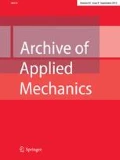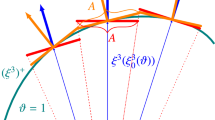Abstract
The primary aim of this study is to establish the theoretical foundations for a solid–fluid biphasic mixture domain that can accommodate inertial effects and a viscous interstitial fluid, which can interface with a dynamic viscous fluid domain. Most mixture formulations consist of constituents that are either all intrinsically incompressible or compressible, thereby introducing inherent limitations. In particular, mixtures with intrinsically incompressible constituents can only model wave propagation in the porous solid matrix, whereas those with compressible constituents require internal variables, and related evolution equations, to distinguish the compressibility of the solid and fluid under hydrostatic pressure. In this study, we propose a hybrid framework for a biphasic mixture where the skeleton of the porous solid is intrinsically incompressible but the interstitial fluid is compressible. We define a state variable as a measure of the fluid volumetric strain. Within an isothermal framework, the Clausius–Duhem inequality shows that a function of state arises for the fluid pressure as a function of this strain measure. We derive jump conditions across hybrid biphasic interfaces, which are suitable for modeling hydrated biological tissues. We then illustrate this framework using confined compression and dilatational wave propagation analyses. The governing equations for this hybrid biphasic framework reduce to those of the classical biphasic theory whenever the bulk modulus of the fluid is set to infinity and inertia terms and viscous fluid effects are neglected. The availability of this novel framework facilitates the implementation of finite element solvers for fluid-structure interactions at interfaces between viscous fluids and porous-deformable biphasic domains, which can include fluid exchanges across those interfaces.


Similar content being viewed by others
References
Truesdell, C., Toupin, R.: Encyclopedia of Physics. Springer, Berlin (1960). vol. III/1, chap. The classical field theories
Green, A.E., Naghdi, P.M.: On basic equations for mixtures. Q. J. Mech. Appl. Math. 22(4), 427 (1969)
Bowen, R.M.: Theory of Mixtures. Continuum Physics. Academic Press, New York (1976)
Bedford, A., Drumheller, D.S.: Theories of immiscible and structured mixtures. Int. J. Eng. Sci. 21(8), 863 (1983)
Mow, V.C., Kuei, S.C., Lai, W.M., Armstrong, C.G.: Biphasic creep and stress relaxation of articular cartilage in compression: theory and experiments. J. Biomech. Eng. 102(1), 73 (1980). https://doi.org/10.1115/1.3138202
Oomens, C.W., van Campen, D.H., Grootenboer, H.J.: A mixture approach to the mechanics of skin. J. Biomech. 20(9), 877 (1987)
Lai, W.M., Hou, J.S., Mow, V.C.: A triphasic theory for the swelling and deformation behaviors of articular cartilage. J. Biomech. Eng. 113(3), 245 (1991)
Huyghe, J.M., Janssen, J.: Quadriphasic mechanics of swelling incompressible porous media. Int. J. Eng. Sci. 35(8), 793 (1997)
Humphrey, J.D., Rajagopal, K.R.: A constrained mixture model for arterial adaptations to a sustained step change in blood flow. Biomech. Model. Mechanobiol. 2(2), 109 (2003). https://doi.org/10.1007/s10237-003-0033-4
Ateshian, G.A., Maas, S., Weiss, J.A.: Multiphasic finite element framework for modeling hydrated mixtures with multiple neutral and charged solutes. J. Biomech. Eng. 135, 11 (2013). https://doi.org/10.1115/1.4024823
Kenyon, D.E.: The theory of an incompressible solid-fluid mixture. Arch. Ration. Mech. Anal. 62(2), 131 (1976). https://doi.org/10.1007/bf00248468
Bowen, R.M.: Incompressible porous media models by use of the theory of mixtures. Int. J. Eng. Sci. 18(9), 1129 (1980)
Ateshian, G.A.: The role of interstitial fluid pressurization in articular cartilage lubrication. J. Biomech. 42, 1163 (2009). https://doi.org/10.1016/j.jbiomech.2009.04.040
Ateshian, G.A., Warden, W.H., Kim, J.J., Grelsamer, R.P., Mow, V.C.: Finite deformation biphasic material properties of bovine articular cartilage from confined compression experiments. J. Biomech. 30, 1157 (1997). https://doi.org/10.1016/s0021-9290(97)85606-0
Huang, C.Y., Soltz, M.A., Kopacz, M., Mow, V.C., Ateshian, G.A.: Experimental verification of the roles of intrinsic matrix viscoelasticity and tension-compression nonlinearity in the biphasic response of cartilage. J. Biomech. Eng. 125, 84 (2003). https://doi.org/10.1115/1.1531656
Park, S., Krishnan, R., Nicoll, S.B., Ateshian, G.A.: Cartilage interstitial fluid load support in unconfined compression. J. Biomech. 36, 1785 (2003). https://doi.org/10.1016/s0021-9290(03)00231-8
Smith, J.H., García, J.J.: A nonlinear biphasic model of flow-controlled infusion in brain: fluid transport and tissue deformation analyses. J. Biomech. 42(13), 2017 (2009). https://doi.org/10.1016/j.jbiomech.2009.06.014
Lande, B., Mitzner, W.: Analysis of lung parenchyma as a parametric porous medium. J. Appl. Physiol. 101(3), 926 (2006). https://doi.org/10.1152/japplphysiol.01548.2005
Ricken, T., Dahmen, U., Dirsch, O.: A biphasic model for sinusoidal liver perfusion remodeling after outflow obstruction. Biomech. Model. Mechanobiol. 9(4), 435 (2010). https://doi.org/10.1007/s10237-009-0186-x
Chapelle, D., Gerbeau, J.F., Sainte-Marie, J., Vignon-Clementel, I.E.: A poroelastic model valid in large strains with applications to perfusion in cardiac modeling. Comput. Mech. 46(1), 91 (2009). https://doi.org/10.1007/s00466-009-0452-x
Cimrman, R., Rohan, E. Modelling heart tissue using a composite muscle model with blood perfusion. In Computational Fluid and Solid Mechanics 2003, Elsevier, pp. 1642–1646. (2003) https://doi.org/10.1016/b978-008044046-0.50400-0
Ateshian, G.A., Costa, K.D., Hung, C.T.: A theoretical analysis of water transport through chondrocytes. Biomech. Model. Mechanobiol. 6(1–2), 91 (2006). https://doi.org/10.1007/s10237-006-0039-9
Barocas, V.H., Tranquillo, R.T.: An anisotropic biphasic theory of tissue-equivalent mechanics: the interplay among cell traction, fibrillar network deformation, fibril alignment, and cell contact guidance. J. Biomech. Eng. 119(2), 137 (1997). https://doi.org/10.1115/1.2796072
Guilak, F., Mow, V.C.: The mechanical environment of the chondrocyte: a biphasic finite element model of cell–matrix interactions in articular cartilage. J. Biomech. 33(12), 1663 (2000). https://doi.org/10.1016/s0021-9290(00)00105-6
Causin, P., Guidoboni, G., Harris, A., Prada, D., Sacco, R., Terragni, S.: A poroelastic model for the perfusion of the lamina cribrosa in the optic nerve head. Math. Biosci. 257, 33 (2014). https://doi.org/10.1016/j.mbs.2014.08.002
Chen, X., Dunn, A.C., Sawyer, W.G., Sarntinoranont, M.: A biphasic model for micro-indentation of a hydrogel-based contact lens. J. Biomech. Eng. 129(2), 156 (2006). https://doi.org/10.1115/1.2472373
Tandon, P.N., Autar, R.: Biphasic model of the trabecular meshwork in the eye. Med. Biol. Eng. Comput. 29(3), 281 (1991). https://doi.org/10.1007/bf02446710
Biot, M.A., Temple, G.: Theory of finite deformations of porous solids. Indiana Univ. Math. J. 21(7), 597–620 (1972)
Hou, J.S., Holmes, M.H., Lai, W.M., Mow, V.C.: Boundary conditions at the cartilage-synovial fluid interface for joint lubrication and theoretical verifications. J. Biomech. Eng. 111(1), 78–87 (1989). https://doi.org/10.1115/1.3168343
Hou, J., Mow, V., Lai, W., Holmes, M.: An analysis of the squeeze-film lubrication mechanism for articular cartilage. J. Biomech. 25(3), 247–259 (1992). https://doi.org/10.1016/0021-9290(92)90024-u
Chan, B., Donzelli, P.S., Spilker, R.L.: A mixed-penalty biphasic finite element formulation incorporating viscous fluids and material interfaces. Ann. Biomed. Eng. 28(6), 589–597 (2000). https://doi.org/10.1114/1.1305529
Badia, S., Quaini, A., Quarteroni, A.: Coupling Biot and Navier-Stokes equations for modelling fluid-poroelastic media interaction. J. Comput. Phys. 228(21), 7986–8014 (2009). https://doi.org/10.1016/j.jcp.2009.07.019
Unnikrishnan, G., Unnikrishnan, V., Reddy, J.: Tissue–fluid interface analysis using biphasic finite element method. Comput. Methods Biomech. Biomed. Eng. 12(2), 165–172 (2009). https://doi.org/10.1080/10255840802372045
Brinkman, H.: A calculation of the viscous force exerted by a flowing fluid on a dense swarm of particles. Flow Turbul. Combust. 1(1), 27 (1949)
Bukac, M., Yotov, I., Zakerzadeh, R., Zunino, P.: Effects of poroelasticity on fluid-structure interaction in arteries: a computational sensitivity study. In: MS&A, pp. 197–220. Springer, (2015). https://doi.org/10.1007/978-3-319-05230-4_8
Yang, M., Taber, L.A., Clark, E.B.: A nonlinear poroelastic model for the trabecular embryonic heart. J. Biomech. Eng. (1994)
Berger, L., Bordas, R., Burrowes, K., Grau, V., Tavener, S., Kay, D.: A poroelastic model coupled to a fluid network with applications in lung modelling. Int. J. Numer. Methods Biomed. Eng. (2015). https://doi.org/10.1002/cnm.2731
Tully, B., Ventikos, Y.: Coupling poroelasticity and CFD for cerebrospinal fluid hydrodynamics. IEEE Trans. Biomed. Eng. 56(6), 1644–1651 (2009). https://doi.org/10.1109/tbme.2009.2016427
Bowen, R.M.: Compressible porous media models by use of the theory of mixtures. Int. J. Eng. Sci. 20(6), 697–735 (1982). https://doi.org/10.1016/0020-7225(82)90082-9
de Boer, R.: Theory of Porous Media. Springer, Berlin (2000). https://doi.org/10.1007/978-3-642-59637-7
Mow, V.C., Lai, W.M.: Recent developments in synovial joint biomechanics. SIAM Rev. 22(3), 275–317 (1980)
Ateshian, G.A., Ricken, T.: Multigenerational interstitial growth of biological tissues. Biomech. Model. Mechanobiol. 9(6), 689–702 (2010). https://doi.org/10.1007/s10237-010-0205-y
Ateshian, G.A.: On the theory of reactive mixtures for modeling biological growth. Biomech. Model. Mechanobiol. 6(6), 423–445 (2007). https://doi.org/10.1007/s10237-006-0070-x
Holmes, M.H.: Finite deformation of soft tissue: analysis of a mixture model in uni-axial compression. J. Biomech. Eng. 108(4), 372–81 (1986). https://doi.org/10.1115/1.3138633
Lai, W.M., Hou, J.S., Mow, V.C.: A triphasic theory for the swelling and deformation behaviors of articular cartilage. J. Biomech. Eng. 113(3), 245–258 (1991). https://doi.org/10.1115/1.2894880
Ateshian, G.A., Albro, M.B., Maas, S., Weiss, J.A.: Finite element implementation of mechanochemical phenomena in neutral deformable porous media under finite deformation. J. Biomech. Eng. 133, 8 (2011). https://doi.org/10.1115/1.4004810
Shim, J.J., Maas, S.A., Weiss, J.A., Ateshian, G.A.: A formulation for fluid-structure interactions in febio using mixture theory. J. Biomech. Eng. (2019). https://doi.org/10.1115/1.4043031
Holmes, M.H., Mow, V.C.: The nonlinear characteristics of soft gels and hydrated connective tissues in ultrafiltration. J. Biomech. 23(11), 1145–56 (1990). https://doi.org/10.1016/0021-9290(90)90007-p
Ateshian, G.A.: Mixture Theory for Modeling Biological Tissues: Illustrations from Articular Cartilage, pp. 1–51. Springer, Cham (2017). https://doi.org/10.1007/978-3-319-41475-1_1
Mansour, J.M., Mow, V.C.: The permeability of articular cartilage under compressive strain and at high pressures. J. Bone Joint Surg. Am. 58(4), 509–16 (1976)
Mow, V.C., Mansour, J.M.: The nonlinear interaction between cartilage deformation and interstitial fluid flow. J. Biomech. 10(1), 31–9 (1977). https://doi.org/10.1016/0021-9290(77)90027-6
Holmes, M.H., Lai, W.M., Mow, V.C.: Singular perturbation analysis of the nonlinear, flow-dependent compressive stress relaxation behavior of articular cartilage. J. Biomech. Eng. 107(3), 206–18 (1985). https://doi.org/10.1115/1.3138545
Ateshian, G.A., Shim, J.J., Maas, S.A., Weiss, J.A.: Finite element framework for computational fluid dynamics in FEBio. J. Bio. Eng. (2018). https://doi.org/10.1115/1.4038716
Eringen, A.C., Ingram, J.D.: A continuum theory of chemically reacting media–i. Int. J. Eng. Sci. 3(2), 197–212 (1965)
Beavers, G.S., Joseph, D.D.: Boundary conditions at a naturally permeable wall. J. Fluid Mech. 30(1), 197–207 (1967)
Biot, M.A.: Theory of propagation of elastic waves in a fluid-saturated porous solid I Low-frequency range. J. Acoust. Soc. Am. 28(2), 168–178 (1956). https://doi.org/10.1121/1.1908239
Maas, S.A., Ateshian, G.A., Weiss, J.A.: FEBio: History and advances. Annu. Rev. Biomed. Eng. 19(1), 279–299 (2017). https://doi.org/10.1146/annurev-bioeng-071516-044738
Brooks, A.N., Hughes, T.J.: Streamline upwind/petrov-galerkin formulations for convection dominated flows with particular emphasis on the incompressible navier-stokes equations. Comput. Methods Appl. Mech. Eng. 32(1–3), 199–259 (1982). https://doi.org/10.1016/0045-7825(82)90071-8
Bazilevs, Y., Calo, V.M., Hughes, T.J.R., Zhang, Y.: Isogeometric fluid-structure interaction: theory, algorithms, and computations. Comput. Mech. 43(1), 3–37 (2008). https://doi.org/10.1007/s00466-008-0315-x
Funding
Division of Graduate Education, U.S. National Science Foundation (Grant No. NSF GRFP DGE-16-44869). National Institute of General Medical Sciences, U.S. National Institutes of Health (Award No. R01GM083925).
Author information
Authors and Affiliations
Corresponding author
Ethics declarations
Disclaimer
The content is solely the responsibility of the authors and does not necessarily represent the official views of the National Institutes of Health or the National Science Foundation.
Additional information
Publisher's Note
Springer Nature remains neutral with regard to jurisdictional claims in published maps and institutional affiliations.
Rights and permissions
About this article
Cite this article
Shim, J.J., Ateshian, G.A. A hybrid biphasic mixture formulation for modeling dynamics in porous deformable biological tissues. Arch Appl Mech 92, 491–511 (2022). https://doi.org/10.1007/s00419-020-01851-8
Received:
Accepted:
Published:
Issue Date:
DOI: https://doi.org/10.1007/s00419-020-01851-8




